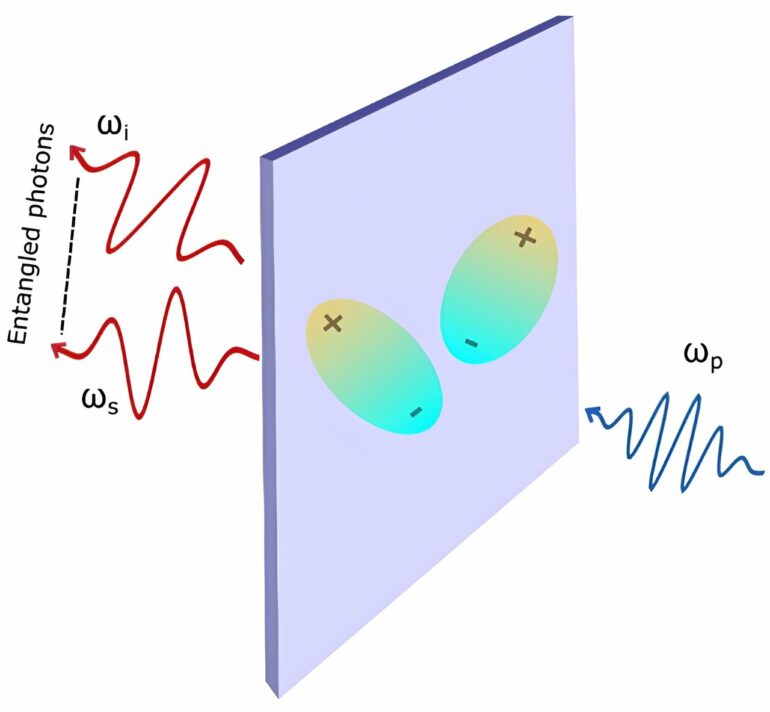Scientists from the National University of Singapore (NUS) have shown that excitonic resonances and transitions between excitons can significantly increase the efficiency of generating entangled photon pairs. This could lead to the development of efficient ultrathin quantum light sources.
Quantum entanglement is the cornerstone of many quantum technologies. In simple terms, it describes a phenomenon where the properties of two quantum particles are linked, even when they are far apart.
Entangled photons, which are massless particles of light, are typically generated by shining light (called the “pump” beam) on certain types of crystals known as non-linear optical crystals through a process called spontaneous parametric down-conversion (SPDC). However, SPDC is inherently a rather inefficient process.
The research team, led by Associate Professor Su Ying Quek from the Department of Physics at NUS, has shown that the efficiency of SPDC can be enhanced by harnessing many-body excitonic interactions present in the non-linear optical crystal.
These excitonic interactions occur between negative and positive charges that are created when light interacts with the crystal. Known as excitons, these pairs of opposite charges arise from the crystal’s fundamental excitations. The team showed that when these charges are closer together, SPDC efficiency increases significantly, depending on the light’s energy or frequency.
The research findings were published in the journal Physical Review Letters.
These predictions were made using fully quantum mechanical calculations to analyze the non-linear optical response of crystals to incident light and to account for excitonic effects.
Dr. Fengyuan Xuan, the lead author of this work, explained, “SPDC is fundamentally a non-linear optical process that involves transitions between the fundamental excitations in the crystal. The probability of these transitions increases when the opposite charges due to excitations in the crystal are located more closely to each other.
“This effect was evident when our results were compared with a more conventional treatment that neglects the interaction between the negative and positive charges.”
Prof Quek said, “The use of ultrathin crystals can eliminate a technical challenge associated with SPDC, known as the phase matching problem. Although ultrathin crystals were usually avoided for SPDC because their efficiency was believed to decrease with the material volume, the stronger excitonic interactions in these ultrathin crystals can alleviate this effect. This makes ultrathin crystals a viable source for producing entangled photons.”
The team applied the theoretical approach to NbOI2, a layered non-linear optical material, to study both SPDC and second harmonic generation (SHG), the reverse process of SPDC. They simulated SHG intensities based on the polarization angle of incident light and found that these simulations agreed well with previously published experimental work.
They also discovered that the excitonic enhancement is particularly strong when the frequency of the “pump” beam closely matches an excitation frequency in the crystal. Additionally, the SPDC can be further enhanced if one of the entangled photons has a frequency matching another excitation frequency in the crystal.
“These discoveries pave the way for generating entangled photons using ultrathin materials, which can be more easily integrated into hybrid quantum-photonic platforms for next generation devices,” added Prof Quek.
More information:
Fengyuan Xuan et al, Exciton-Enhanced Spontaneous Parametric Down-Conversion in Two-Dimensional Crystals, Physical Review Letters (2024). DOI: 10.1103/PhysRevLett.132.246902. On arXiv: DOI: 10.48550/arxiv.2305.08345
Provided by
National University of Singapore
Citation:
Ultrathin quantum light sources: Scientists show excitonic interactions boost efficiency of entangled photon generation (2024, August 19)



